Build Strength From Head to Toe With This Full-Body Circuit Workout
Taking a break from the road to strength train can do wonders for your body. Not only will it improve your strength, but also your performance when you get back on the saddle.
While your strength workout could focus on specific body parts, like the glutes or back, if you really want to maximize your time, your best best is to follow a full-body circuit workout, like this one created by Dane Miklaus, C.S.C.S., founder of WORK Training Studio in Irvine, California.
A full-body strength-training program is absolutely vital for any athlete, whether they be a weekend warrior or sponsored, Miklaus tells Runner’s World. Not only will it help improve speed and efficiency, but it will correct imbalances and serve as insurance against injuries, he says.
The Benefits of This Full-Body Circuit Workout
This circuit was designed by Miklaus to strengthen all your key cycling muscles (head to toe!). It also saves you time, thanks to compound exercises that hit multiple muscles at one time. By using a set of dumbbells, you also add more resistance, which helps you build strength and also levels up the challenge.
Throughout the workout, you get a mix of moves that work your muscles in new directions and in creative ways, helping to challenge your body outside of the typical forward-moving motion of your ride. With each move, the goal is to stabilize your midsection so you learn to build core strength, while working your entire body. You’ll also get your heart rate up throughout this workout, helping to build aerobic capacity in a new way.
How to use this list: Perform each exercise in the order below for 45 seconds, and rest for 15 to 20 seconds between each move. Complete 2-3 sets. Each move is demonstrated by Cory Pickert, certified trainer at WORK Training Studio, in the video above so you can master the proper form. You will need a set of dumbbells. An exercise mat is optional.
Miklaus recommends practicing his routine two to three times a week on non-running days.
1. Press Jack
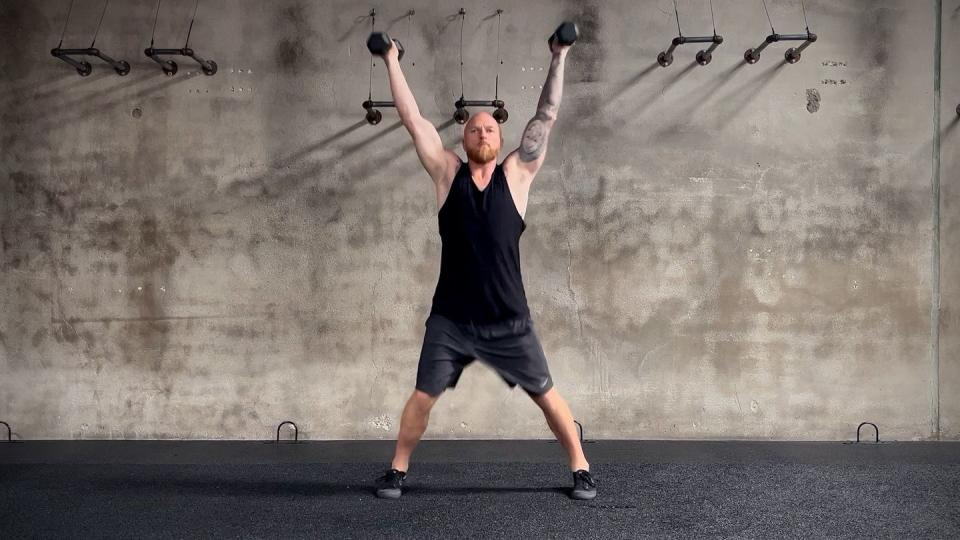
Why it works: This move is great because it strengthens many muscles in one cardio-intense move—shoulders, core, muscles of the lateral hip, and muscles around the ankle. This exercise stabilizes and challenges cyclists to move directionally in a way they most likely neglect, Miklaus says.
How to do it: Stand with feet together, arms by sides with a dumbbell in each hand, held at shoulders, palms facing your face. Jump feet wide while simultaneously extending arms above head in a Y shape. Then jump feet back together and bring arms back down to shoulders. Repeat. Land softly with each jump.
2. Bent-Over Reverse Press
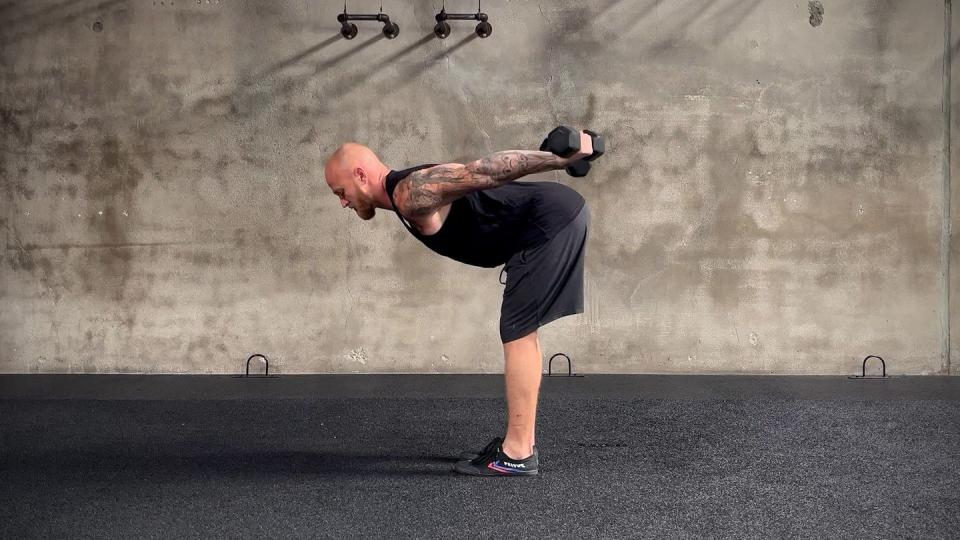
Why it works: Practicing this move will help strengthen the stabilizing muscles around the shoulder, as well as the lats and triceps.
How to do it: Stand with feet shoulder-width apart and hold a dumbbell in each hand, palms facing behind you. Keeping core engaged and back flat, bend knees slightly and hinge forward at the hips, so torso is nearly parallel to the ground and arms are hanging directly below shoulders. This is the starting position. Keeping neck neutral and elbows straight, press arms back and up so that the dumbbells lift higher than hips. Slowly return to the starting position. Repeat.
3. Skier With Reverse Lunge
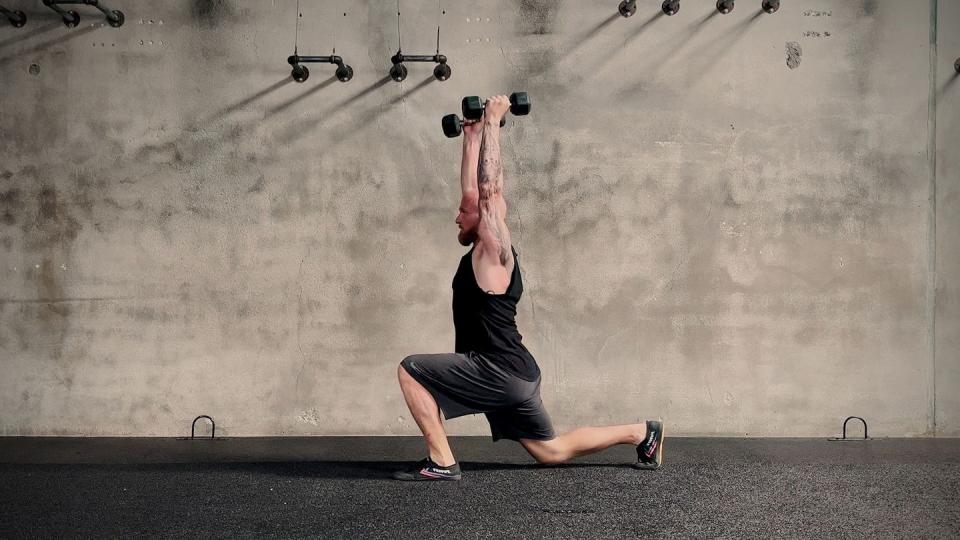
Why it works: This complex move targets important cycling muscles in the legs and torso, and will help develop a solid core.
How to do it: Start standing with feet hip-width apart and a dumbbell in each hand. Hinge at the hips, keeping back flat and core tight, and driving both arms behind you. Then drive the feet into the floor and extend the hips (use your glutes for power), as you simultaneously bring the arms straight up overhead and step backward with left foot into a reverse lunge, both knees bending 90 degrees. Press through right foot to stand back up, immediately going back into your hinge position with feet hip-width apart and dumbbells driving behind you. Repeat on opposite side. Continue alternating.
4. Push-Up to Renegade Row

Why it works: Push-ups are one of the most effective exercises to help cyclists strengthen their core muscles. “By adding in a dumbbell row with this variation, the goal isn’t so much to activate the upper back muscles as it is to stimulate even more core activation,” Miklaus says. That’s because your core has to fight to avoid the rotation of the hips.
How to do it: Start in a high plank position with each hand on a dumbbell, wrists under shoulders, core engaged so body forms a straight line from head to heels. Place feet wider than hip-width apart. Bend elbows to form a 45-degree angle with body, lowering chest and full body to the floor. Exhale and push back up to plank. Then engage back muscles to slowly pull right hand up to the ribcage then slowly return the weight to the floor. Repeat on left side. Continue performing the push-up and one row on each side.
5. Squat to Woodchop
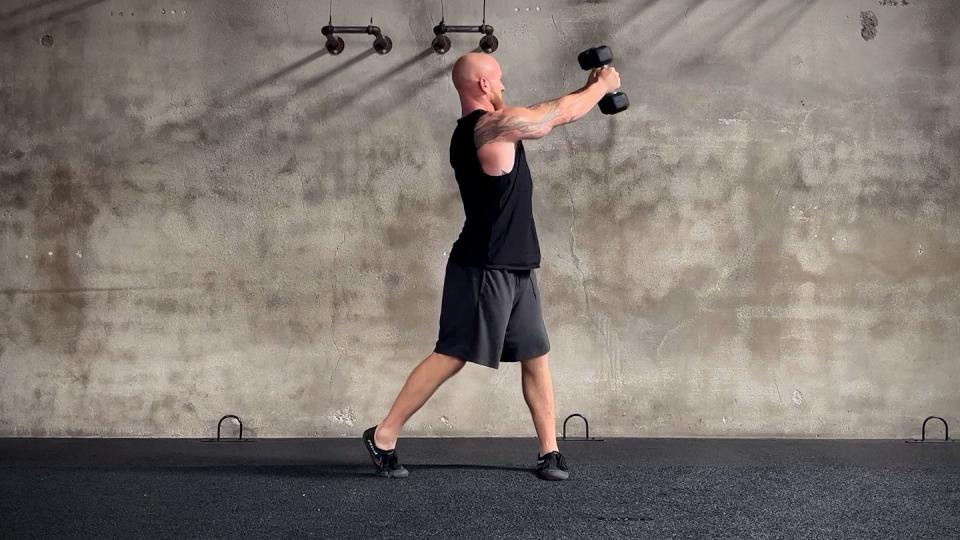
Why it works: Practicing this move, “makes you connect your mind to your movement and body more, and it can assist in the development of agility and reactivity,” Miklaus says, which is what you need to tackle varying terrain. This exercise is also great for working in a different plane of motion, as it gets cyclists to move in the transverse (or rotational) plane.
How to do it: Stand with feet slightly wider than hip-width apart, holding a dumbbell in each hand, arms down in front of you with dumbbells together. Lower into a squat by sending hips down and back, dumbbells reaching toward the floor. Then drive through feet to stand back up, and as you do, pivot feet and twist torso to the left (keep shoulders over hips), bringing dumbbells to shoulder level. Lower the weights back down in front as you lower back into a squat. Repeat on other side. Continue alternating.
6. V-Up
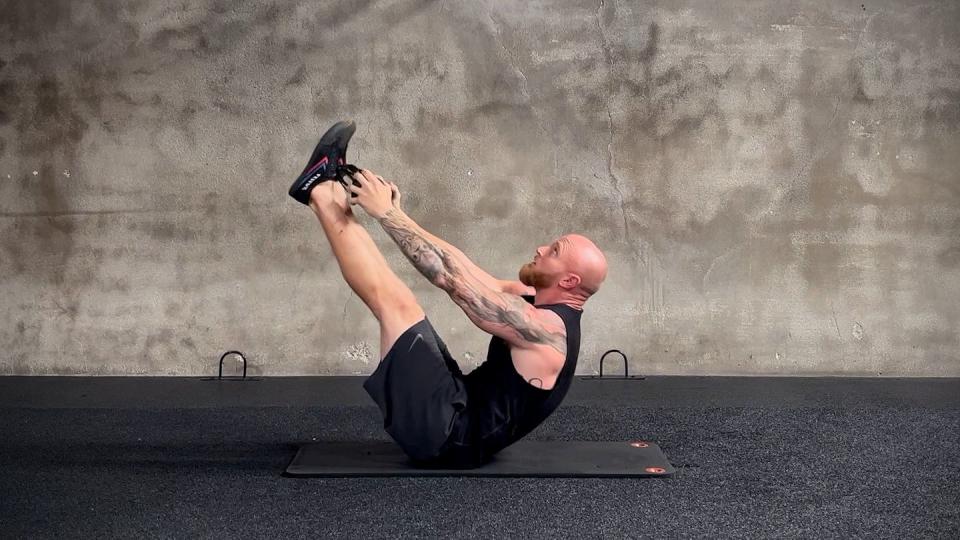
Why it works: “The goal is to not only lift up with both the trunk and legs as high as possible, but also to be able to lower down with complete control,” Miklaus says. This exercise targets the abs and hip flexors.
How to do it: Lie faceup with legs extended, arms above the head with both hands holding a dumbbell horizontally. Lift head, shoulders, and legs off the floor and into a V position. Slowly lower back down. Repeat.
You Might Also Like

